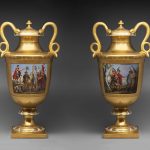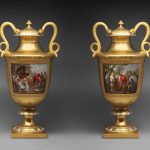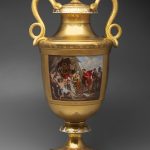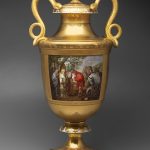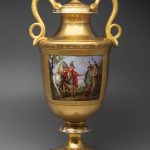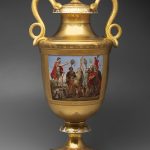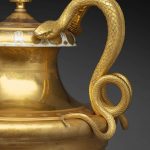Une paire de grand vases couverts en porcelaine royale de Vienne
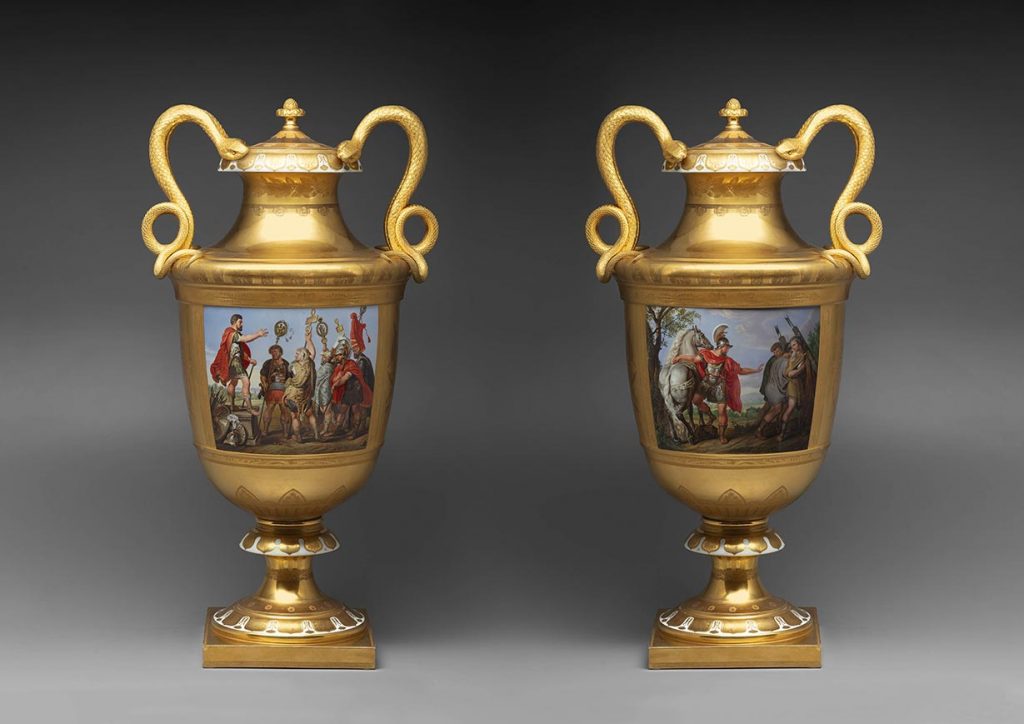
A pair of large gilt bronze-mounted Royal Vienna porcelain covered vases
with scenes after Rubens’s Decius Mus cycle,
signed Leopold Lieb and dated 1817
Underglaze blue Austrian Bindenschild device
Impressed marks 816 and 817 for Vienna 1816/17
Impressed white ware turner’s mark 25
Height: 82 cm. (32 ¼ in.) Width: 44 cm. (17 ¼ in.)
Depth: 35 cm. (13 ¾ in.)
The fields with a gilt background decorated with trophies of arms and friezes of palmettes, fleurons and rosettes in matte and gloss. The gilt bronze handles in the shape of snakes.
Provenance
Possibly commissioned by Johann I Joseph, Prince of Liechtenstein (1760-1836)
Sold Sotheby’s London, around 1990 TBC, then Sold Christie’s London, before 1996 TBC[1]
With Galerie Aveline, Paris
Private Parisian collection
Comparative Literature
R.Baumstark, ‘The Decius Mus Cycle’, in exh. cat. Liechtenstein. The Princely Collections, New York, Metropolitan Museum of Art, 26 Oct 1985 – 1 May 1986, B.D. Kelleher (ed.), New York, 1985, pp. 338ff., nos. 210-217.
J.Kräftner (ed.), Der Fürst als Sammler: Neuerwerbungen unter Hans-Adam II. von und zu Liechtenstein, exh. cat., Vienna, Liechtenstein Museum, 12 Feb – 24 Aug 2010, pp. 284-285.
This pair of large vases originally formed the flanking elements of a three-part garniture with an even larger central vase en suite. Of exceptionally large size for Vienna porcelain, the garniture might have been ordered by Johann I Joseph, Prince of Liechtenstein (r. 1805-1806 and 1814-1836) to celebrate one of the jewels of his art collection, Peter Paul Rubens’s Decius Mus pictorial cycle. Executed in 1616/17, this was the first historical cycle undertaken by Rubens and consists of eight large oils, commissioned by an unnamed group of Genoese merchants as cartoons for a tapestry series of which over 20 sets are known (Baumstark, op. cit., nos. 210-217).
Each vase is painted with two scenes from the cycle, as detailed below. The central vase (fig. 5) presents the two paintings that close the narrative: the Death and Obsequies of Decius Mus.[2] Of the cycle’s remaining two paintings, the one designed for entre-fenêtre tapestries depicts Roman arms (fig. 6), so it is interesting that the vases’ side panels are likewise decorated with trophies.
The Decius Mus cycle
Publius Decius Mus was a Roman consul in 340 BC. Livy in book 8 of the History of Rome tells of his sacrifice in battle through the ritual of devotio following an oracular announcement received in a dream. The vases reproduce four key moments in the narrative as painted by Rubens:
- Decius Mus announces his oracular dream to his troops (fig. 1)
- A soothsayer confirms Decius Mus’s fate through sacrificial ritual (fig. 2)
- Decius Mus undergoes the solemn rite of devotio (fig. 3)
- The Roman lictors (magistrates) are dispatched by Decius Mus to tell his co-consul Titus Manlius that he has chosen to die for the good of the army (fig. 4)
The original paintings were acquired by Prince Hans-Adam I of Liechtenstein in 1693, who then commissioned sumptuous carved cartouches for their frames from the sculptor Giovanni Giuliani. From the moment of acquisition, they have always been considered one of the glories of the Liechtenstein Princely Collections (Baumstark, op. cit., pp. 338-341).
The Vienna Porcelain Manufactory
The Vienna hard-paste porcelain manufactory was founded in 1718, the second in Europe after Meissen. By the beginning of the 19th century, the manufacture had reached its apogee under the direction of Conrad von Sorgenthal, producing wares in Neoclassical tase with Sèvres porcelain the main influence. After attending the Academy of Fine Arts, Léopold Lieb (1771-1836) was employed by Sorgenthal from 1800 as an enameller, specializing primarily in history scenes until 1834.
The Liechtenstein Princely Collections also contains a Vienna porcelain plaque depicting the soothsayer scene (Kräftner, op. cit., pp. 284-285; fig. 7), as well as a plate painted by Lieb after Wouwermans (inv. 2691).
[1] Per Jean-Marc Rossi of Aveline (email to Vincent Bastien forwarded to Izarn)

